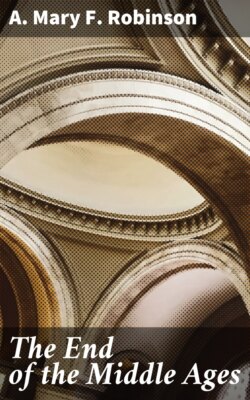Читать книгу The End of the Middle Ages - A. Mary F. Robinson - Страница 14
На сайте Литреса книга снята с продажи.
XI.
ОглавлениеTable of Contents
But sister Katrei had too many followers, and gradually the sense of the religious world revolted from this numb and dead ideal. Already, in the writings of Suso (1335), of Ruysbrock, and Rulmann Merswin, men whose idealist mysticism was little different from the Beguine heresy, the quietism of these “false freemen” is utterly condemned. Suso, in his Book of Truth, recounts how he met on a journey one of these wandering Beghards, who, to all his questions, responded much as Parsifal responds to Gurnemanz. Whence he came and whither going, the wanderer does not know. He is called the Nameless Savage. He is Nothing abysmed in the Divine Nothingness. Without will or desire he obeys his natural instincts, since any conflict with them would destroy the quiet of his soul. Such is the latest type of the secular brotherhood; but this, unlike Sister Katrei, meets no approval from the marvelling Church.
Indeed, the Beghards and the Beguines, with their lax morals, their mendicant insolence, had become an insupportable burden. So, in despair, in 1328 the Church, as we have said, delivered fifty of them to the secular arm, and these were burned, as an example, in Cologne. The persecution was now steadfast and continuous; but still in secret places, and by strange underground channels, the pantheistpantheist idea spread on unseen—pantheism which now was no longer vague and veiled. “We do not believe in God, and we do not love Him, and we do not adore Him, and we do not hope in Him, for this would be to avow that He is other than ourselves.” Thus speak these heretics of the fourteenth century. So far have they pushed the phrase, God is all that exists.
From this time the cohesive force of Beguinism rapidly diminishes. In 1365 Pope Urban V. still speaks of the “children of Belial, Beghards and Beguines,” but their name slips gradually out of the chronicles of edicts and of councils. Or it is applied to any new sect of heretics. In 1373 we hear of “the Beghards or Turlupins,” and in the next century Beghard is frequently synonymous with Lollard. The great heresy of the Free Spirit was divided into a hundred unimportant divisions. By the middle of the fifteenth century, thethe Beghards and Beguines were either orthodox communities of some tertiary order, or scattered hermits, living in woods and forests, and stealthily keeping red the few embers left of pantheistic heresy. It seemed as if the movement were really stamped out. But the phrase of Mechtild was not so easily confuted. No man can burn an idea.
We hear no more, it is true, of the Beguines or of the Weaving Brothers; but in the sixteenth century, when at Wittenberg and at Strasburg, at Basle and at Meaux, the great idea of the Reformation simultaneously awoke, in that period of spiritual ferment, the pantheism of the secular fraternities flamed out again, and more fiercely than before. The libertines, the anabaptists, and familists of the sixteenth century preserved in a coarser form the persecuted tradition of the Beghards and the Beguines.
